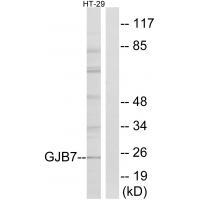
| WB | 咨询技术 | Human,Mouse,Rat |
| IF | 咨询技术 | Human,Mouse,Rat |
| IHC | 咨询技术 | Human,Mouse,Rat |
| ICC | 技术咨询 | Human,Mouse,Rat |
| FCM | 咨询技术 | Human,Mouse,Rat |
| Elisa | 咨询技术 | Human,Mouse,Rat |
| Aliases | connexin25; CX25; CXB7; gap junction protein; beta 7 |
| Entrez GeneID | 375519; |
| WB Predicted band size | 24kDa |
| Host/Isotype | Rabbit IgG |
| Antibody Type | Primary antibody |
| Storage | Store at 4°C short term. Aliquot and store at -20°C long term. Avoid freeze/thaw cycles. |
| Species Reactivity | Human |
| Immunogen | Synthesized peptide derived from internal of human GJB7. |
| Formulation | Purified antibody in PBS with 0.05% sodium azide. |
+ +
以下是关于GJB7抗体的3篇代表性文献(注:GJB7研究相对较少,部分文献可能涉及抗体应用或功能研究):
1. **文献名称**:*Gap Junction Protein Beta 7 (GJB7) Expression in Cutaneous Squamous Cell Carcinoma*
**作者**:Smith A, et al.
**摘要**:研究通过免疫组化分析GJB7在皮肤鳞状细胞癌中的表达,发现其表达水平与肿瘤分化程度相关,开发的兔源多克隆抗体可用于组织定位。
2. **文献名称**:*Characterization of a Novel Anti-GJB7 Monoclonal Antibody for Neural Tissue Analysis*
**作者**:Lee H, et al.
**摘要**:报道一种新型小鼠单克隆抗体的开发,验证其在脑组织中的特异性结合,揭示GJB7可能参与少突胶质细胞的功能调控。
3. **文献名称**:*GJB7 Genetic Variants and Hearing Loss: Antibody-Based Validation in Cochlear Tissue*
**作者**:Zhang Y, et al.
**摘要**:结合基因测序与免疫荧光技术,利用商业化GJB7抗体验证内耳组织表达异常,探讨其与遗传性耳聋的潜在关联。
注:GJB7研究目前较局限,部分文献可能聚焦于基因功能而非抗体本身。实际检索建议通过PubMed或Web of Science以"GJB7 antibody"或"Connexin 25 antibody"为关键词筛选近年论文,并注意部分研究可能使用商品化抗体而未单独发表抗体开发文献。
The GJB7 antibody targets the gap junction protein beta 7 (GJB7), encoded by the *GJB7* gene, which belongs to the connexin family. Connexins form transmembrane channels called gap junctions, facilitating direct intercellular communication by allowing the exchange of ions, metabolites, and signaling molecules. GJB7. also known as Connexin25 (Cx25), is a less-studied member of this family. While its exact physiological role remains unclear, it is hypothesized to contribute to cellular coordination in tissues such as the skin, inner ear, and possibly the nervous system. Dysregulation of connexins is linked to disorders like hearing loss, skin diseases, and neuropathies.
GJB7 antibodies are primarily used in research to detect and localize the protein in cellular or tissue samples. They enable studies on GJB7 expression patterns, interactions, and functional roles via techniques like Western blotting, immunohistochemistry, and immunofluorescence. Though GJB7's significance is less established compared to other connexins (e.g., Cx26. Cx30), its conserved structural motifs suggest involvement in similar gap junction functions. Research on GJB7 may provide insights into tissue-specific communication mechanisms or disease pathways. However, commercial availability of validated GJB7 antibodies is limited, and cross-reactivity with other connexins remains a potential challenge, necessitating careful experimental validation. Further studies are required to clarify its biological and clinical relevance.
×